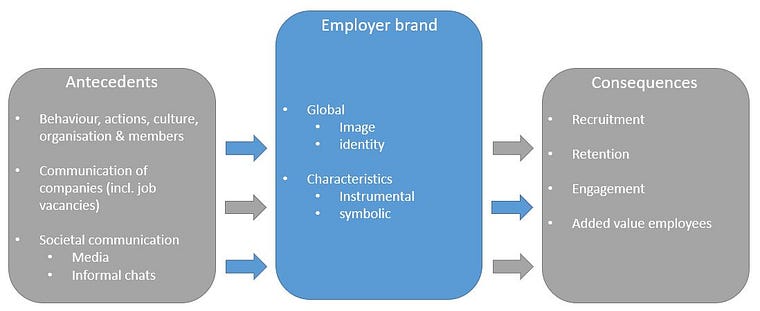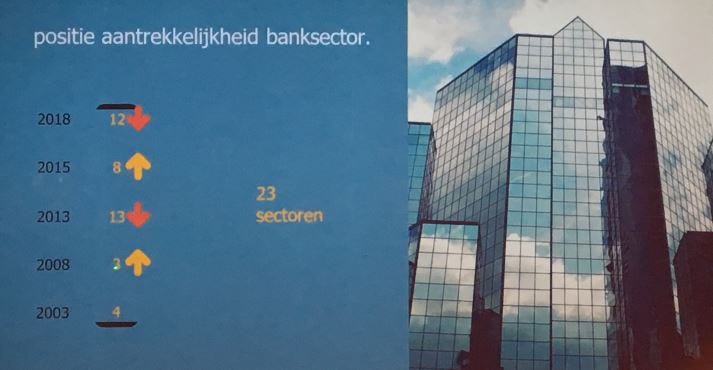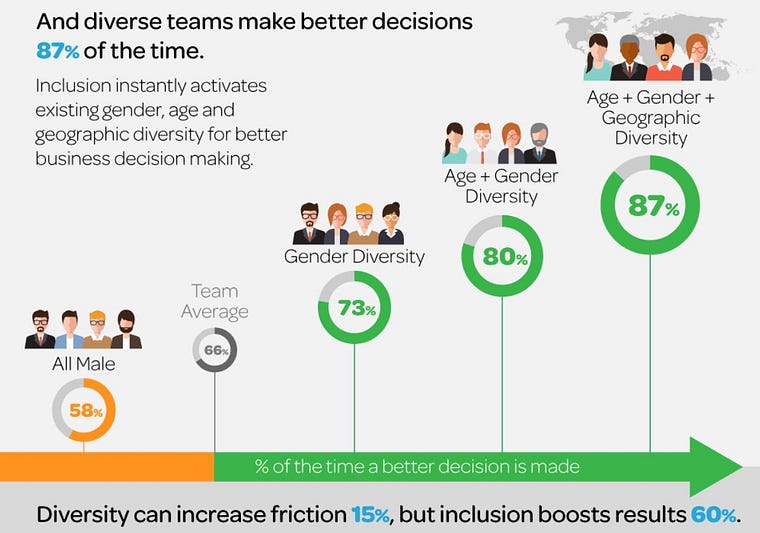The financial services sector has a problem… it is not a hidden problem at the back of their systems, or… well… maybe they have, but that is not what I will be writing about. They have a problem with branding. More specifically employer branding…
Banks need more talent, especially digital talent. It is an unfortunate coincidence that a lot of this required talent today is also highly attractive to other sectors. Since everything is digitized, everyone is fishing talent in the same pool.
On the other hand, financial services have lost a lot of its attractivity that it used to have on the labour market. Everyone wanted to work in a bank 10–20 years ago. Today this is not longer the case.
So how can banks reposition themselves to stand out in the war for new talent?
That was the question of an information session by Febelfin and Randstad that I attended last week. Karel Van Eetvelt (CEO Febelfin), Jan Denys (Director External Communication and Public Affairs Labour Market Expert at Randstad) and Claire Godding (Head
of Diversity and Inclusion at BNP Paribas Fortis) set the scene before going into a great debate to discuss, not only the problem, but also to provide a list of possible ideas to overcome the problem that employer branding is bringing to financial services
today.
What is employer branding?
Before going to the remedy, I think it is crucial for you to know what employer branding is all about.
Wikipedia describes it very well: “Employer brand describes an employer’s reputation as a place to work, and their employee value proposition, as opposed to the more general corporate brand reputation and value proposition to customers”. It goes much further
than just salary conditions and flexible working hours (although these are important elements as well).

What elements define an employer brand?
- Identity: Who are you? What do you stand for? Who were you before? Who do you want to be in the future?
- Image: How to others look at you? What reputation have you developed, as a company and as an employer? What is the perception people have of you as a company, and as an employer?
Employer branding also depends of following types of characteristics:
- Instrumental: salary, additional advantages, job certainty…
- Symbolic: how do people attach human elements to a brand? F.e.: bank X is an honest employer
An employer brand is determined by its antecedents. Surprisingly 80% of what makes an employer brand can be linked to the behaviour of a sector or a company (I guess you start feeling where this is going, right?).
Communication (internal and external), job descriptions, and mentions in the press are other important elements that influence employer branding, together with the way the external world talks about your brand.
I guess you start to feel were it went wrong for financial services…
What is the problem with the image of the sector?
Two of the most obvious reasons that makes banks less attractive today for young graduates (and other potential employees) is:
- The financial crisis: banks are pointed at as being the reason of this major crisis.
- The forced redundancies and branch closures the last decades
These 2 elements have an enormous impact on the image of financial institutions. People are not confident to start at a bank. The changed attitude of young graduates that they are not looking for a life-long employer, doesn’t change this.
What is wrong with the identity of financial services?
The banking sector today is experiencing a huge transformation, which makes it a highly interesting case of employer branding. Most of this has to do with identity. Better said: the lack of identity.
In the past it was clear what a bank was: a banker was an advisor of financial services. It provided payments, savings and credit services.
Digitalisation today is what makes banks rethink their identity. They get competition in the same area of financial services advise by new players, new organisations that don’t call themselves a bank: Fintechs!
Fintechs focus on real niches: they only offer investment products online (cfr. Birdee, MeDirect…), or they only offer daily banking services (cfr. bpost, Compte Nikkel, N26). Consumers start getting confused. Tomorrow this gets even worse. If all the studies
and statements of the big consulting companies prove to be true, we will see traditional banks disappear in the age of Open Banking and Phantomization.
Say what???
In the near future, bank will have to choose how to stay relevant in the age of the platforms. They need to find their identity again in the new reality of financial services.
- Should a bank be a product factory? The focus of the bank will be to look for new, external, sales channels to increase scale in an effort to remains efficient;
- Should a bank be a seller of products? The focus of the bank will be to offer the best user experience and to look for the best products to provide this through its channels;
- Should a bank just be a platform? The bank will evolve towards an IT company that interconnects all kind of services and provides its licenses as a service;
- Is there another roles banks should play?
There is a lot of uncertainty of how banks will look like in the future. This uncertainty is also reflected in its identity, or lack of identity, and in the way external people identify banks.
What does this mean for the sector?
Banking is losing its attractiveness on the labour market. In a list of 23 sectors, banks are in the right column the last few years, on the 12th place (compared to 8th place in 2015).

Keep in mind that 10 years ago, right before the crisis, banks were still one of the favourite sectors to work for. Over 10 years the banking sector suffered a lot with both its identity and its perception by society. This has huge consequences, not only
in recruitment, but also in retention and engagement of employees.
The sector now starts to understand the problem, and they are now actively looking for solutions to resolve this. It is a question that requires a reflexion that goes way beyond incentives for employees.
This led to a few very interesting reflections, no clear action points. This should not be a surprise, since every bank should decide how to contribute to the better image and cleared identity of the bank.
The speakers, as well as the panellists had a list of interesting, often out-of-the-box ideas. Most of this started from the idea that banks should do a reset of their employer brand, and try to reinvent themselves (Jan Denys).
Building brands is a long-term plan of which we cannot have the solution tomorrow. I will share a few of the discussed ideas here. I hope they can also be a source of inspiration for you.
Banks should take responsibility on topics they have impact on
“Confidence will return from the moments we take up what keeps people awake, banks should take responsibility on topics that have a real impact for society” Karel Van Eetvelt, CEO Febelfin
Banks should go back to basics and reflect on their relevance in society. Sven Mastbooms went one step further in his reflection:
banks should move from customer centricity, which is revenue based, to human centricity, which is the more fundamental reason why banks exist
(more on this at
#tbsconf19, where Banking for Humanity is the central theme ;)).
Once people understand the role of banks, they will also much easier identify themselves with this role, and better understand the relevance of banks. As a consequence they will be more willing to fulfil this role as well.
“We should break the cliché image that banks still have as being white suited employees with too much money” Claire Godding, Head of Diversity & Inclusion BNP Paribas Fortis
Google bank, and go to images. You see? Banking is not
at all a diverse sector, at least not in the perception of people. BNP Paribas Fortis is doing a lot of effort to change this.
Breaking with this image has multiple benefits: a multicultural corporate culture will lead to new, more diverse ideas, which will benefit the company as a whole.
Cloverpop made this very visible:
 by Cloverpop: Infographic: Diversity + Inclusion = Better Decision Making At Work
by Cloverpop: Infographic: Diversity + Inclusion = Better Decision Making At Work
Aside from that it will also be easier to fish in a bigger pool for talent. For BNP Paribas Fortis this is of strategic importance:
- They participate in multicultural job fairs;
- They actively promote the employment of physically challenged individuals, also as role models, both internally and to the outside world
- Job students will not only be recruited at employee family members but a certain amount of student jobs wil also be filled by minorities
- There is a special attention for gender equality and career development for women
- Actively stimulate informal groups that represent certain minorities (LGBT…
“Build on your strongest assets for employment. Don’t just like a what goes wrong, look at what remains” Sven Mastbooms, CEO Kindred Spirits
Banks have an enormous diversity in terms to jobs. They also activ
ely promote internal job rotation. Some banks are even looking at external experience for their employees, like for the elderly for which digitalisation is going too fast.
This could just be the right USP (unique selling proposition) for banks as an employer: try to be the employer that allows one to be ready in 3–4 years to start anywhere he/she likes.
Pretty neat idea. But it completely breaks with the current ideas of HR that focuses on retention. Mind you: this kind of USP will not automatically result in a higher churn of employees. For many of them, the idea of being ready to start somewhere else
gives an idea of freedom, of flexibility, the idea of “we put your career in your hands”. They may just be the right mindset to stay longer! It will not automatically lead to job switching.
Rewrite job descriptions: job descriptions are often not properly explaining the job it describes, a sometimes even worse element with job descriptions is that these are very often not gender neutral.
This is not always explicitly visible, but a test of Watson (from IBM) showed that even when the computer took over the selection for the best applicant for a job, that result seemed discriminatory.
It takes a lot of reflection and work to make job descriptions gender neutral, but it will general a lot of value for the organisation. It drives diversity, and I explained already before what diversity brings when it comes to good decision making.
These were just a few of the possible remedies that were discussed. Employer branding is a long term project, so I am sure a lot more will be written on this topic in the future.
I hope this post helped you understand at least already the basics on this topic, and that it helps you to contribute as well in the future.